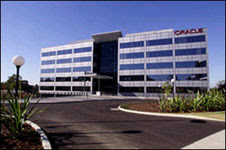 I read an interesting article this morning on the Australian IT website where Lindsay Tanner (Finance Minister) was quoted as saying "The rise of internet-enabled peer production as a social force necessitates a rethink about how policy and politics is done in Australia". He went on to say "In the longer term, governments will have to adapt to information's new online center of gravity."
I read an interesting article this morning on the Australian IT website where Lindsay Tanner (Finance Minister) was quoted as saying "The rise of internet-enabled peer production as a social force necessitates a rethink about how policy and politics is done in Australia". He went on to say "In the longer term, governments will have to adapt to information's new online center of gravity."The challenge for companies like Oracle who provide Web and Enterprise 2.0 technologies to Federal and State Government departments is changing the mind-set that was established some years ago when EDRMS solutions were first pitched and sold. Departments brought off on the grandiose (post edit: meaning more complicated that was actually required at the time) idea that they would be able to effectively manage electronic and physical documents through a single solution - allowing their content-creation processes to be supplemented by formal records keeping procedures within a single solution. However, in a lot of cases - only the records management solution was actually implemented - the document creation environment was often deemed too-hard or unnecessary for the department and placed additional constraints on the information workforce.
If Mr. Tanner's approach is to be successful, and we wish him every success in what he is trying to achieve, then these departments have to truly embrace the thought that their staff and their customers (you and I) will require an easy-to-use solution that provides information in context and enables participation within the process. Sounds like a load of marketing speak? Let me explain.....
Ease of access to information requires some radical rethinking on the way that information is presented to the end-user. Simply deploying a solution that implements "Windows Explorer" on the Web isn't good enough and nor is a solution that implements itself as a raft of non-integrated silos of information. The Solution needs to be enterprise-class and needs to embrace and implement the Web/Enterprise 2.0 way of accessing information. Search rather than navigation is the key here and to make search work well - information categorization and classification needs to be automated and consistent. Users searching for information will retrieve relevant information based upon the terms that are entered or the keywords/tags selected. This is what we call information-context.
The context in which information is searched for should follow-through to the way that the retrieved information is presented to the user. If we take the tax office (ATO) as an example, searching for the term "Christmas Trees" could result in many fragments of information being retrieved from the repository(s). By providing context to the search, the results can be narrowed enabling the right information to be presented to the user - ordering by relevance. The user may be searching for the tax rules relating to the sale of Christmas Trees from a private residence - this is the information context and the end-user facing interface needs to take this into account. Once found, the user may want to start an online conversation about the tax-rules and this is what we call participation.
Participation allows multiple persons to collaborate on an initiative which may be as simple as asking a question to a government tax-advisor or as complex as the creation of a new tax rule within the tax office itself. In either event, security and privacy become a challenge if using some of the historic information management solutions or even through some of the latest offerings from information-management vendors. Security needs to be tightly integrated into any environment where participation or collaboration is enabled and it isn't as simple as introducing a directory-service with authentication unfortunately. When information passes through the traditional firewalls of an organisation - through eMail or through a Laptop being removed from site - there is a risk, and it is ever increasing seemingly, of the information falling into the wrong hands. Take for example, a government department who is working on a new policy affecting certain members of the population. The department is liaising with external organisations including lawyers, consultants and advisors. Information, and I'm referring primarily to documentation (Word, Excel, PPT in general), can be leaked to the public or to the press accidentally or otherwise. Implementing a solution where the control of access to this information can be guaranteed is a highly-desirable requirement when information-management requirements embrace Web/Enterprise 2.0. We call this Information Rights Management (IRM).
Mr. Tanner went on to say "that the Government not only had to adapt to a world moving online, but would have to do so at an ever-increasing pace. As a huge creator and manager of information with an obligation to be open and transparent, we have little choice."
We think that Mr. Tanner is onto something here, the government is the largest manager of information and needs to look to implement a more-open approach for the access of information - both internally and externally.
Paul


1 comment:
Tanner often seems to be the only member of the Federal Government with a clue on most tech related issues. And he seems to be a thinker as well. Pity he's not driving some other key national initiatives (like broadband or filtering the internet).
Post a Comment